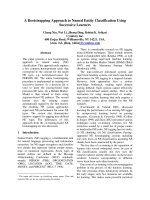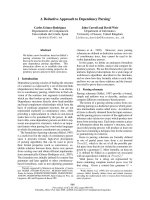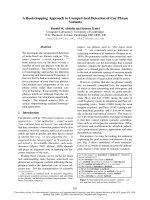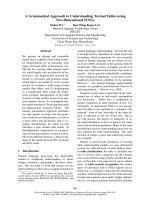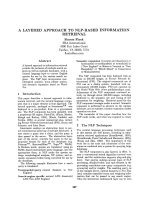Báo cáo khoa học: "A Flexible Approach to Natural Language Generation for Disabled Children" pdf
Bạn đang xem bản rút gọn của tài liệu. Xem và tải ngay bản đầy đủ của tài liệu tại đây (519.23 KB, 6 trang )
Proceedings of the COLING/ACL 2006 Student Research Workshop, pages 1–6,
Sydney, July 2006.
c
2006 Association for Computational Linguistics
A Flexible Approach to Natural Language Generation for Disabled
Children
Pradipta Biswas
School of Information Technology
Indian Institute of Technology, Kharagpur 721302 INDIA
Abstract
Natural Language Generation (NLG) is a
way to automatically realize a correct ex-
pression in response to a communicative
goal. This technology is mainly explored
in the fields of machine translation, re-
port generation, dialog system etc. In this
paper we have explored the NLG tech-
nique for another novel application-
assisting disabled children to take part in
conversation. The limited physical ability
and mental maturity of our intended users
made the NLG approach different from
others. We have taken a flexible ap-
proach where main emphasis is given on
flexibility and usability of the system.
The evaluation results show this tech-
nique can increase the communication
rate of users during a conversation.
1 Introduction
‘Natural Language Generation’ also known as
‘Automated Discourse Generation’ or simply
‘Text Generation’, is a branch of computational
linguistics, which deals with automatic genera-
tion of text in natural human language by the
machine. It can be conceptualized as a process
leading from a high level communicative goal to
a sequence of communicative acts that accom-
plish this communicative goal (Rambow et. al.,
2001). Based on input representation, any NLG
technique can be broadly classified into two
paradigms viz. Template based Approach and
Plan based approach. The template-based ap-
proach does not need large linguistic knowledge
resource but it cannot provide the expressiveness
or flexibility needed for many real domains
(Langkilde and Knight, 1998). In (Deemter et.
al., 1999), it has been tried to prove with the ex-
ample of a system (D2S: Direct to Speech) that
both of the approaches are equally powerful and
theoretically well founded. The D2S system uses
a tree structured template organization that re-
sembles Tag Adjoining Grammar (TAG) struc-
ture. The template-based approach that has been
taken in the system, enables the basic language
generation algorithms application independent
and language independent. At the final stage of
language generation it checks the compatibility
of the sentence structure with the current context
and validates the result with Chomsky’s binding
theory. For this reason it is claimed to be as well
founded as any plan-based approach. As another
practical example of NLG technique, we can
consider the IBM MASTOR system (Liu et. al.,
2003). It is used as speech-to-speech translator
between English and Mandarin Chinese. The
NLG part of this system uses trigram language
model for selecting appropriate inflectional form
for target language generation.
When NLG (or NLP) technology is ap-
plied in assistive technology, the focus is shifted
to increase communication rate rather than in-
creasing the efficiency of input representation.
As for example, CHAT (Alm, 1992) software is
an attempt to develop a predictive conversation
model to achieve higher communication rate dur-
ing conversation. This software predicts different
sentences depending on situation and mood of
the user. The user is free to change the situation
or mood with a few keystrokes. In “Compan-
sion” project (McCoy, 1997), a novel approach
was taken to enhance the communication rate.
The system takes telegraphic message as input
and automatically produces grammatically cor-
rect sentences as output based on NLP tech-
niques. The KOMBE Project (Pasero, 1994) tries
to enhance the communication rate in a different
way. It predicts a sentence or a set of sentence by
taking sequence of words from users. The San-
yog project (Sanyog, 2006)(Banerjee, 2005) ini-
tiates a dialog with the users to take different
portions (eg. Subject, verb, predicate etc.) of a
sentence and automatically constructs a gram-
matically correct sentence based on NLG tech-
niques.
1
2 The Proposed Approach
The present system is intended to be used by
children with severe speech and motor-
impairment. It will cater those children who can
understand different parts of a sentence (like sub-
ject, object, verb etc.) but do not have the compe-
tence to construct a grammatically correct sen-
tence by properly arranging words. The intended
audience offers both advantages and challenges
to our NLG technique. The advantage is we can
limit the extent of sentence types that have to be
generated. But the challenges overwhelm this
advantage. The main challenges identified so far
can be summarized as follows.
Simplicity in interacting with user due to
limited mental maturity level of users
Flexibility in taking input
Generating sentences with minimum
number of keystrokes due to the limited
physical ability of the users
Generating the most appropriate sen-
tence in the first chance since we do not
have any scope to provide users a set of
sentences and ask them to choose one
from the set.
In the next few sections the NLG technique
adopted in our system will be discussed in de-
tails. Due to limited vocabulary and education
level of our intended users, our NLG technique
will generate only simple active voice sentences.
The challenges are also tried to be addressed in
developing the NLG technique.
Generally an NLG system can be divided into
three modules viz. Text Planning, MicroPlanning
and Realization. In (Callaway and Lester, 1995),
the first two modules are squeezed into a plan-
ning module and results only two subtasks in an
NLG system. Generally in all the approaches of
NLG, the process starts with different parts of a
sentence and each of these parts can be desig-
nated as a template. After getting values for these
templates the templates are arranged in a speci-
fied order to form an intermediate representation
of a sentence. Finally the intermediate represen-
tation undergoes through a process viz. Surface
realization to form a grammatically correct and
fluent sentence. Thus any NLG technique can be
broadly divided into two parts
Templates fill up
Surface realization
Now each of these two steps for our system will
be discussed in details.
2.1 Templates fill up
We defined templates for our system based on
thematic roles and Parts of Speech of words. We
tagged each sentence of our corpus (the corpus is
discussed in section 4.1) and based on this
tagged corpus, we have classified the templates
in two classes. One class contains the high fre-
quency templates i.e. templates that are con-
tained in most of the sentences. Examples of this
class of templates include subject, verb, object
etc. The other class contains rest of the tem-
plates. Let us consider the first class of templates
are designated by set A={a1,a2,a3,a4….} and
other class is set B={b1,b2,b3,b4,………… }.
Our intention is to offer simplicity and flexibility
to user during filling up the templates. So each
template is associated with an easy to understand
phrase like
Subject=> Who
Verb=> Action
Object=> What
Destination=>To Where
Source=>From Where……… etc.
To achieve the flexibility, we show all the tem-
plates in set A to user in the first screen (the
screenshot is given in fig. 1, however the screen
will not look as clumsy as it is shown because
some of the options remain hidden by default and
appear only on users’ request). The user is free to
choose any template from set A to start sentence
construction and is also free to choose any se-
quence during filling up values for set A. The
system will be a free order natural language gen-
erator i.e. user can give input to the system using
any order; the system will not impose any par-
ticular order on the user (as imposed by the San-
yog Project). Now if the user is to search for all
the templates needed for his/her sentence, then
both the number of keystrokes and cognitive load
on user will increase. So with each template of
set A we defined a sequence of templates taking
templates from both set A and set B. Let user
chooses template a
k.
Now after filling up tem-
plate ak, user will be prompted with a sequence
of templates like ak1, ak2, ak3, bk1, bk2, bk3,
etc. to fill up. Again the actual sequence that will
be prompted to user will depend on the input that
is already given by user. So the final sequence
shown to the user will be a subset of the prede-
fined sequence. Let us clear the concept with an
example. Say a user fills up the template <Desti-
nation>. Now s/he will be requested to give val-
ues for template like <Source>, <Conveyance>,
<Time>, <Subject> etc, excluding those which
2
are already filled up. As the example shows, the
user needs not to search for all templates as well
as s/he needs not to fill up a template more than
once. This strategy gives sentence composition
with minimum number of keystrokes in most of
the cases.
2.2 Surface Realization
It consists of following steps
Setting verb form according to the tense
given by user
Setting Sense
Setting Mood
Phrase ordering to reflect users intention
Each of these steps is described next.
The verb form will be modified according to the
person and number of the subject and the tense
choice given by the user.
The sense will decide the type of the sentence i.e.
whether it is affirmative, negative, interrogative
or optative. For negative sense, appropriate nega-
tive word (e.g. No, not, do not) will be inserted
before the verb. The relative position of the or-
der of the subject and verb will be altered for
optative and interrogative sentences.
The mood choice changes the main verb of the
sentence to special verbs like need, must etc. It
tries to reflect the mood of the user during sen-
tence composition.
Finally the templates are grouped to constitute
different phrases. These phrases are ordered ac-
cording to the order of the input given by the
user. This step is further elaborated in section
3.2.
3 A Case Study
In this section a procedural overview of the pre-
sent system will be described. The automatic
language generation mechanism of the present
system uses the following steps
Taking Input from Users
The user has to give input to the system using the
form shown in fig. 1. As shown in the form the
user can select any property (like tense, mood or
sense) or template at any order. The user can se-
lect tense, mood or sentence type by clicking on
appropriate option button. The user can give in-
put for the template by answering to the follow-
ing questions
• Action
• Who
• Whom
• With Whom
• What
• From Where
• To Where
• Vehicle Used ……etc.
After selecting a thematic role, a second form
will come as shown in Fig. 2. From the form
shown at Fig 2, the user can select as many
words as they want. Even if they want they can
type a word (e.g. his /her own name). The punc-
tuations and conjunction will automatically be
inserted.
Fig. 1: Screenshot of dialog based interface
Fig. 2: Screenshot of word selection interface
Template fill-up
After giving all the input the user asks the system
to generate the sentence by clicking on “generate
sentence” Button. The system is incorporated
with several template organizations and a default
3
template organization. Examples of some of
these template organizations are as follows
• SUBJECT VERB
• SUBJECT VERB INANIMATE OBJECT
• SUBJECT VERB ANIMATE OBJECT
• SUBJECT VERB WITH COAGENT
• SUBJECT VERB INANIMATE OBJECT
WITH COAGENT
• SUBJECT VERB INANIMATE OBJECT
WITH INSTRUMENT
• SUBJECT VERB SOURCE DESTINA-
TION BY CONVEYANCE
• SUBJECT VERB SOURCE DESTINA-
TION WITH COAGENT
The system select one such template organization
based on user input and generates the intermedi-
ate sentence representation.
Verb modification according to tense
The intermediate sentence is a simple present
tense sentence. According to the user chosen
tense, the verb of the intermediate sentence get
modified at this step. If no verb is specified, ap-
propriate auxiliary verb will be inserted.
Changing Sentence Type
Up to now the sentence remain as an affirmative
sentence. According to the user chosen sense the
sentence gets modified in this step. E.g. For
question, the verb comes in front, for negative
sentence not, do not, did not or does not is in-
serted appropriately.
Inserting Modal Verbs
Finally the users chosen modal verbs like must,
can or need are inserted into the sentence. For
some modal verbs (like can or need) the system
also changes the form of the verb (like can or
could).
3.1 Example of Sentence Generation using
Our Approach
Let us consider some example of language gen-
eration using our system.
Example 1
Let the user wants to tell, “I am going to school
with father”
Step 1: The user inputs will be
Who => I
To Where => school
With Whom => father
Main Action => go
Tense => Present Continuous
Step 2: Template Organization Selection
Based on user input the following template or-
ganization will be selected
SUBJECT VERB DESTINATION WITH CO-
AGENT
Step 3: Verb Modification according to tense
Since the selected tense is present continuous
and subject is first person singular number, so
‘go’ will be changed to ‘am going’.
Step 4: In this case there is no change of the sen-
tence due to step 4.
Step 5: There is no change of the sentence due to
step 5.
So the final output will be “I am going to school
with father”. It is same as the user intended sen-
tence.
Example 2
Let the user wants to tell, “You must eat it”
Step 1: The user inputs will be
Who => You
Main Action => eat
What => it
Mood => must
Tense => Present Simple
Step 2: Template Organization Selection
Based on user input the following template or-
ganization will be selected
SUBJECT VERB INANIMATE OBJECT
Step 3: Verb Modification according to tense
Since the tense is present simple so there will be
no change in verb.
Step 4: In this case there is no change of the sen-
tence due to step 4.
Step 5: The modal verb will be inserted before
the verb
So the final output will be “You must eat it”
Example 3
Let the user wants to tell, “How are you”
Step 1: The user inputs will be
Who => You
Sense => Question
Wh-word => How
Tense => Present Simple
Step 2: Template Organization Selection
There is no appropriate template for this input.
Hence the default template organization will be
chosen.
Step 3: Verb Modification according to tense
4
Since no action is specified, the auxiliary verb
will be selected as the main verb. Here the sub-
ject is second person and tense is present simple,
so the verb selected is ‘are’.
Step 4: Since the selected sentence type is
‘Question’, so the verb will come in front of the
sentence. Again, since a Wh-word has been se-
lected, it will come in front of the verb. A ques-
tion mark will automatically be appended at the
end of the sentence.
Step 5: There is no change of the sentence due to
step 5.
So the final output will be “How are you?”
3.2 Phase ordering to reflect users’ inten-
tion
An important part of any NLG system is prag-
matics that can be defined as the reference to the
interlocutors and context in communication
(Hovy, 1990). In (Hovy, 1990), a system viz.
PAULINE has been described that is capable of
generating different texts for the same communi-
cative goals based on pragmatics. In PAULINE,
the pragmatics has been represented by rhetorical
goals. The rhetorical goals defined several situa-
tions that dictate all the phases like topic collec-
tion, topic organization and realization. Inspired
from the example of PAULINE the present sys-
tem has also tried to reflect users’ intention dur-
ing sentence realization. Here the problem is the
limited amount of input for making any judicious
judgment. The input to the system is only a se-
quence of words with correspondence to a series
of questions. A common finding is that we ut-
tered the most important concept in a sentence
earlier than other parts of the sentence. So we
have tried to get the users’ intention from the
order of input given by user based on the belief
that the user will fill up the slots in order of their
importance according to his/her mood at that
time. We have associated a counter with each
template. The counter value is taken from a
global clock that is updated with each word se-
lection by the user. Each sentence is divided into
several phrases before realization. Now each
phrase constitute of several templates. For exam-
ple let S be a sentence. Now S can be divided
into phrases like P1, P2, P3… Again each
phrase Pi can be divided into several templates
like T1, T2, T3….Based on the counter value of
each template, we have calculated the rank of
each phrase as the minimum counter value of its
constituent templates i.e.
Rank(Pi)=Minimum(Counter(Tj)) for all j in Pi
Now before sentence realization the phrases are
ordered according to their rank. Each of these
phrase orders produces a separate sentence. As
for example let the communication goal is ‘I go
to school from home with my father’. If the input
sequence is (my father -> I -> go -> school ->
home), the generated sentence will be ‘With my
father I go from home to School’. Again if the
input sequence is (school -> home -> I -> go ->
my father), then the generated sentence will be
‘From home to school I go with my father
.’
Thus for the same communicative goal, the
system produces different sentences based on
order of input given by user.
4 Evaluation
The main goal of our system is to develop a
communication aid for disabled children. So the
performance metrics concentrated on measuring
the communication rate that has little importance
from NLG point of view. To evaluate our system
from NLG point of view we emphasize on the
expressiveness and ease of use of the system.
The expressiveness is measured by the percent-
age of sentences that was intended by user and
also successfully generated by our system. The
ease of use is measured by the average number
of inputs needed to generate each sentence.
4.1 Measuring Expressiveness
To know the type of sentences used by our in-
tended users during conversation, first we ana-
lyzed the communication boards used by dis-
abled children. Then we took part in some actual
conversations with some spastic children in a
Cerebral Palsy institute. Finally we interviewed
their teachers and communication partners.
Based on our research, we developed a list of
around 1000 sentences that covers all types of
sentences used during conversation. This list is
used as a corpus in both development and
evaluation stage of our system. During develop-
ment the corpus is used to get the necessary tem-
plates and for classification of templates (refer
sec. 2.1). After development, we tested the scope
of our system by generating some sentences that
were exactly not in our corpus, but occurred in
some sample conversations of the intended users.
In 96% cases, the system is successful to gener-
ate the intended sentence. After analyzing the
rest 4% of sentence, we have identified following
problems at the current implementation stage.
5
The system cannot handle gerunds as ob-
ject to preposition. (e.g. He ruins his
eyes by reading small letters).
The system is yet not capable to generate
correct sentence with an introductory
‘It’. (e.g. It is summer). In these situa-
tions the sentence is correctly generated
when ‘It’ is given as an agent, which is
not intended.
4.2 Measuring ease of use
To calculate the performance of the system, we
measured the number of inputs given by user for
generating sentence. The input consists of words,
tense choice, mood option and sense choice
given by user. Next we plot the number of inputs
w.r.t. the number of words for each sentence.
Fig. 3 shows the plot. It can be observed from the
plot that as the number of words increases (i.e.
for longer sentences), the ratio of number of in-
puts to number of words decreases. So effort
from users’ side will not vary remarkably with
sentence length. The overall communication rate
is found to be 5.52 words/min (27.44 charac-
ters/min) that is better than (Stephanidis, 2003).
Additionally it is also observed that the commu-
nication rate is increasing with longer conversa-
tions.
5 Conclusion
The present paper discusses a flexible ap-
proach for natural language generation for dis-
abled children. A user can start a sentence gen-
eration from any part of a sentence. The inherent
sentence plan will guide him to realize a gram-
matically correct sentence with minimum num-
ber of keystrokes. The present system respects
the pragmatics of a conversation by reordering
different parts of a sentence following users’ in-
tention. The system is evaluated both from ex-
pressiveness and performance point of views.
Initial evaluation results show this approach can
increase the communication rate of intended us-
ers during conversation.
Acknowledgement
The author is grateful to Media Lab Asia
Laboratory of IIT Kharagpur and Indian Institute
of Cerebral Palsy, Kolkata for exchanging ideas
and providing resources for the present work.
NLG Performance
0
10
20
0 10 20 30
Number of Words
Number of
Inputs
Fig. 3: Line graph for performance meas-
urement of the system
References
Alm N., Arnott J. L., Newell A. F. 1992, Prediction and
Conversational Momentum in an Augmentative Com-
munication System, Communications of the ACM, vol.
55, No. 5, May 1992
Banerjee A. 2005, A Natural Language Generation Frame-
work for an Interlingua-based Machine Translation Sys-
tem, MS Thesis, IIT Kharagpur
Callaway Charles B., Lester James C. 1995, Robust Natural
Language Generation from Large-Scale Knowledge
Bases, Proceedings of the Fourth Bar-Ilan Symposium
on Foundations
Hovy E. H. 1990, Pragmatics and Natural Language Gen-
eration, Artificial Inteligence 43(1990): 153-197
Liu Fu-Hua,Liang Gao Gu,Yuqing, Picheny Michael 2003,
Use of Statistical N_Gram Models in Natural Language
Generation for Machine translation, Proceedings of IEEE
International Conference on Acoustics, Speech, and Sig-
nal Processing, 2003. Vol 1 : 636 639
Langkilde Irene, Knight Kevin 1998, Generation that Ex-
ploits Corpus-Based Statistical Knowledge, Annual
meeting-association for computational linguistics: 704-
710
Deemter Kees van et. al. 1999, Plan-Based vs. template-
based NLG: a false opposition?, Becker and Busemann
(1999)
McCoy K. 1997 , “Simple NLP Techniques for Expanding
Telegraphic Sentences” Natural Language Processing for
Communication Aids,1997
Rambow Owen, Bangalore Srinivas, Walker Marilyn
2001,Natural Language Generation in Dialog System,
Proceedings of the first international conference on Hu-
man language technology research HLT '01
Pasero Robert, Nathalie Richardet and Paul Sabatier;
“Guided Sentences Composition for Disabled People”;
Proceedings of the fourth conference on Applied natural
language processing October 1994
Project SANYOG Available at:
Stephanidis, C. et. al., “Designing Human Computer Inter-
faces for Quadriplegic People”, ACM Transactions on
Computer-Human Interaction, pp 87-118, Vol. 10, No. 2,
June 2003
6
